Accounting Theory and Current Issue: Comparative Analysis Report
VerifiedAdded on 2020/05/08
|29
|4378
|122
Report
AI Summary
This report provides a comprehensive analysis of the accounting policies employed by Insurance Australia Group (IAG), comparing them with those of its competitor, QBE Insurance Group Limited. It delves into the application of positive and normative accounting theories, assessing the flexibility of accounting practices and evaluating the quality of financial disclosures. The report identifies potential red flags in disclosure and examines the companies' compliance with the conceptual framework, highlighting key accounting policies, segment reporting, and the impact of accounting standards. The study also explores incentives for managers, changes in policies, and transaction structuring, offering a detailed examination of the accounting strategies of both companies. The analysis covers aspects such as accounting flexibility, assessment of accounting strategies, quality of disclosure, identification of potential red flags, and compliance with the conceptual framework, providing insights into the financial reporting practices within the insurance industry.
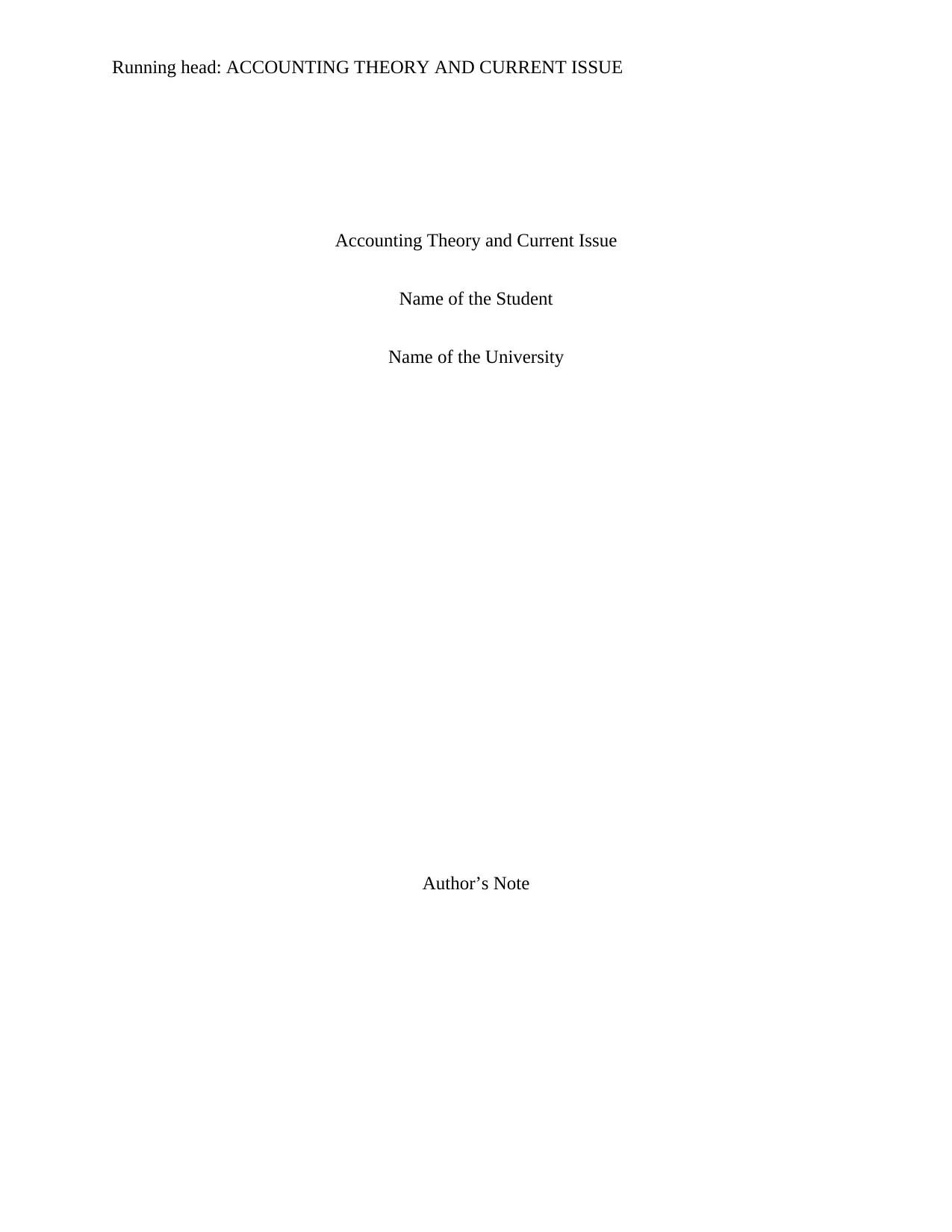
Running head: ACCOUNTING THEORY AND CURRENT ISSUE
Accounting Theory and Current Issue
Name of the Student
Name of the University
Author’s Note
Accounting Theory and Current Issue
Name of the Student
Name of the University
Author’s Note
Paraphrase This Document
Need a fresh take? Get an instant paraphrase of this document with our AI Paraphraser
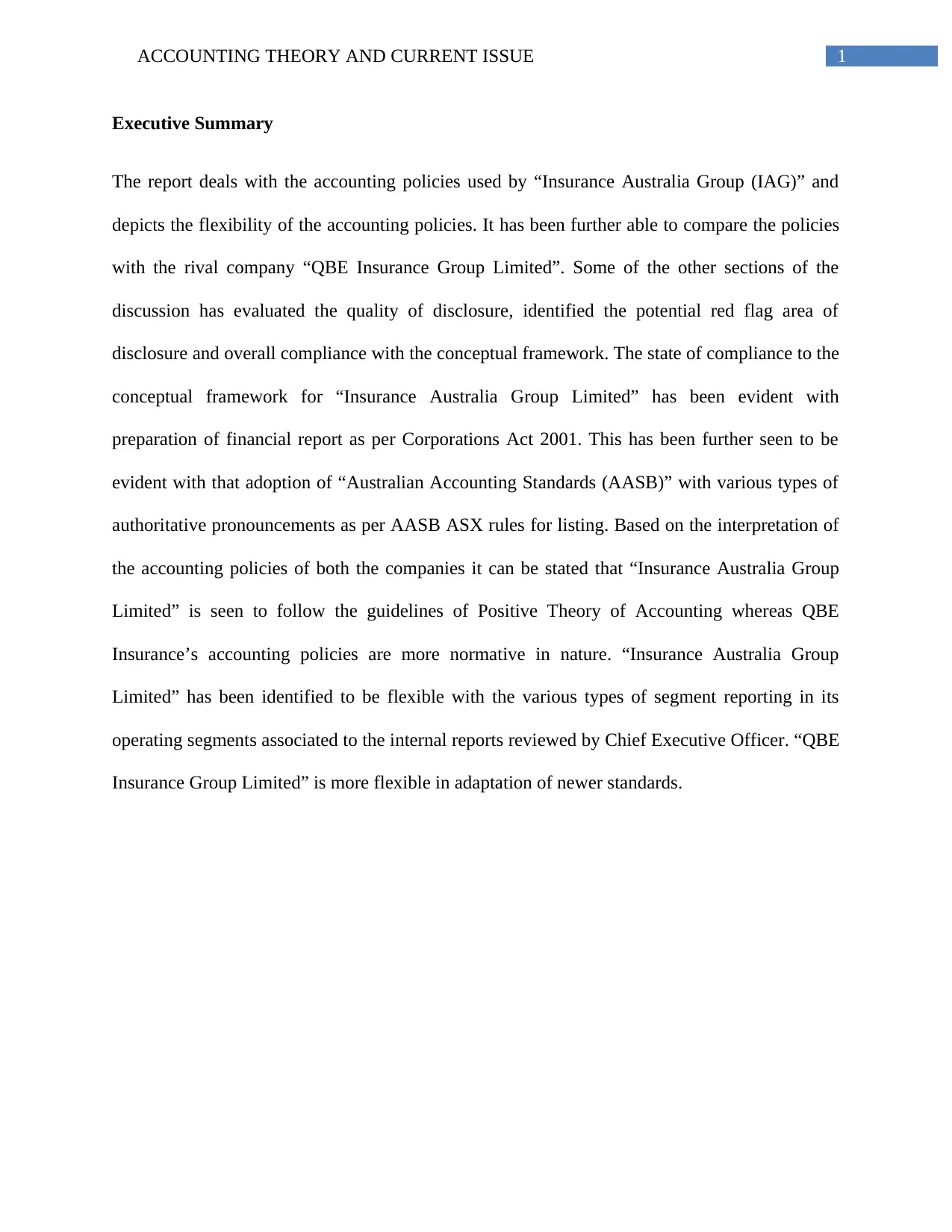
1ACCOUNTING THEORY AND CURRENT ISSUE
Executive Summary
The report deals with the accounting policies used by “Insurance Australia Group (IAG)” and
depicts the flexibility of the accounting policies. It has been further able to compare the policies
with the rival company “QBE Insurance Group Limited”. Some of the other sections of the
discussion has evaluated the quality of disclosure, identified the potential red flag area of
disclosure and overall compliance with the conceptual framework. The state of compliance to the
conceptual framework for “Insurance Australia Group Limited” has been evident with
preparation of financial report as per Corporations Act 2001. This has been further seen to be
evident with that adoption of “Australian Accounting Standards (AASB)” with various types of
authoritative pronouncements as per AASB ASX rules for listing. Based on the interpretation of
the accounting policies of both the companies it can be stated that “Insurance Australia Group
Limited” is seen to follow the guidelines of Positive Theory of Accounting whereas QBE
Insurance’s accounting policies are more normative in nature. “Insurance Australia Group
Limited” has been identified to be flexible with the various types of segment reporting in its
operating segments associated to the internal reports reviewed by Chief Executive Officer. “QBE
Insurance Group Limited” is more flexible in adaptation of newer standards.
Executive Summary
The report deals with the accounting policies used by “Insurance Australia Group (IAG)” and
depicts the flexibility of the accounting policies. It has been further able to compare the policies
with the rival company “QBE Insurance Group Limited”. Some of the other sections of the
discussion has evaluated the quality of disclosure, identified the potential red flag area of
disclosure and overall compliance with the conceptual framework. The state of compliance to the
conceptual framework for “Insurance Australia Group Limited” has been evident with
preparation of financial report as per Corporations Act 2001. This has been further seen to be
evident with that adoption of “Australian Accounting Standards (AASB)” with various types of
authoritative pronouncements as per AASB ASX rules for listing. Based on the interpretation of
the accounting policies of both the companies it can be stated that “Insurance Australia Group
Limited” is seen to follow the guidelines of Positive Theory of Accounting whereas QBE
Insurance’s accounting policies are more normative in nature. “Insurance Australia Group
Limited” has been identified to be flexible with the various types of segment reporting in its
operating segments associated to the internal reports reviewed by Chief Executive Officer. “QBE
Insurance Group Limited” is more flexible in adaptation of newer standards.
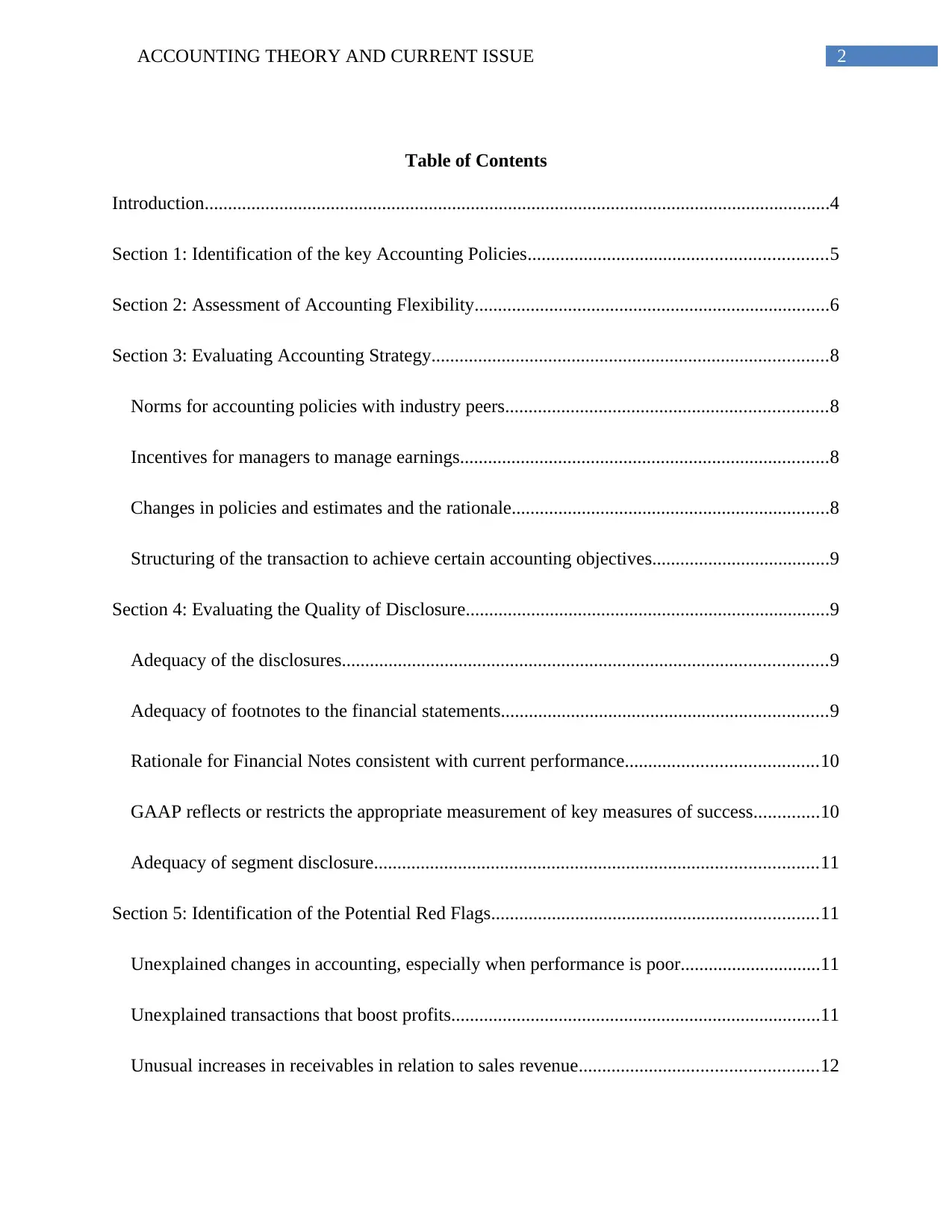
2ACCOUNTING THEORY AND CURRENT ISSUE
Table of Contents
Introduction......................................................................................................................................4
Section 1: Identification of the key Accounting Policies................................................................5
Section 2: Assessment of Accounting Flexibility............................................................................6
Section 3: Evaluating Accounting Strategy.....................................................................................8
Norms for accounting policies with industry peers.....................................................................8
Incentives for managers to manage earnings...............................................................................8
Changes in policies and estimates and the rationale....................................................................8
Structuring of the transaction to achieve certain accounting objectives......................................9
Section 4: Evaluating the Quality of Disclosure..............................................................................9
Adequacy of the disclosures........................................................................................................9
Adequacy of footnotes to the financial statements......................................................................9
Rationale for Financial Notes consistent with current performance.........................................10
GAAP reflects or restricts the appropriate measurement of key measures of success..............10
Adequacy of segment disclosure...............................................................................................11
Section 5: Identification of the Potential Red Flags......................................................................11
Unexplained changes in accounting, especially when performance is poor..............................11
Unexplained transactions that boost profits...............................................................................11
Unusual increases in receivables in relation to sales revenue...................................................12
Table of Contents
Introduction......................................................................................................................................4
Section 1: Identification of the key Accounting Policies................................................................5
Section 2: Assessment of Accounting Flexibility............................................................................6
Section 3: Evaluating Accounting Strategy.....................................................................................8
Norms for accounting policies with industry peers.....................................................................8
Incentives for managers to manage earnings...............................................................................8
Changes in policies and estimates and the rationale....................................................................8
Structuring of the transaction to achieve certain accounting objectives......................................9
Section 4: Evaluating the Quality of Disclosure..............................................................................9
Adequacy of the disclosures........................................................................................................9
Adequacy of footnotes to the financial statements......................................................................9
Rationale for Financial Notes consistent with current performance.........................................10
GAAP reflects or restricts the appropriate measurement of key measures of success..............10
Adequacy of segment disclosure...............................................................................................11
Section 5: Identification of the Potential Red Flags......................................................................11
Unexplained changes in accounting, especially when performance is poor..............................11
Unexplained transactions that boost profits...............................................................................11
Unusual increases in receivables in relation to sales revenue...................................................12
⊘ This is a preview!⊘
Do you want full access?
Subscribe today to unlock all pages.

Trusted by 1+ million students worldwide
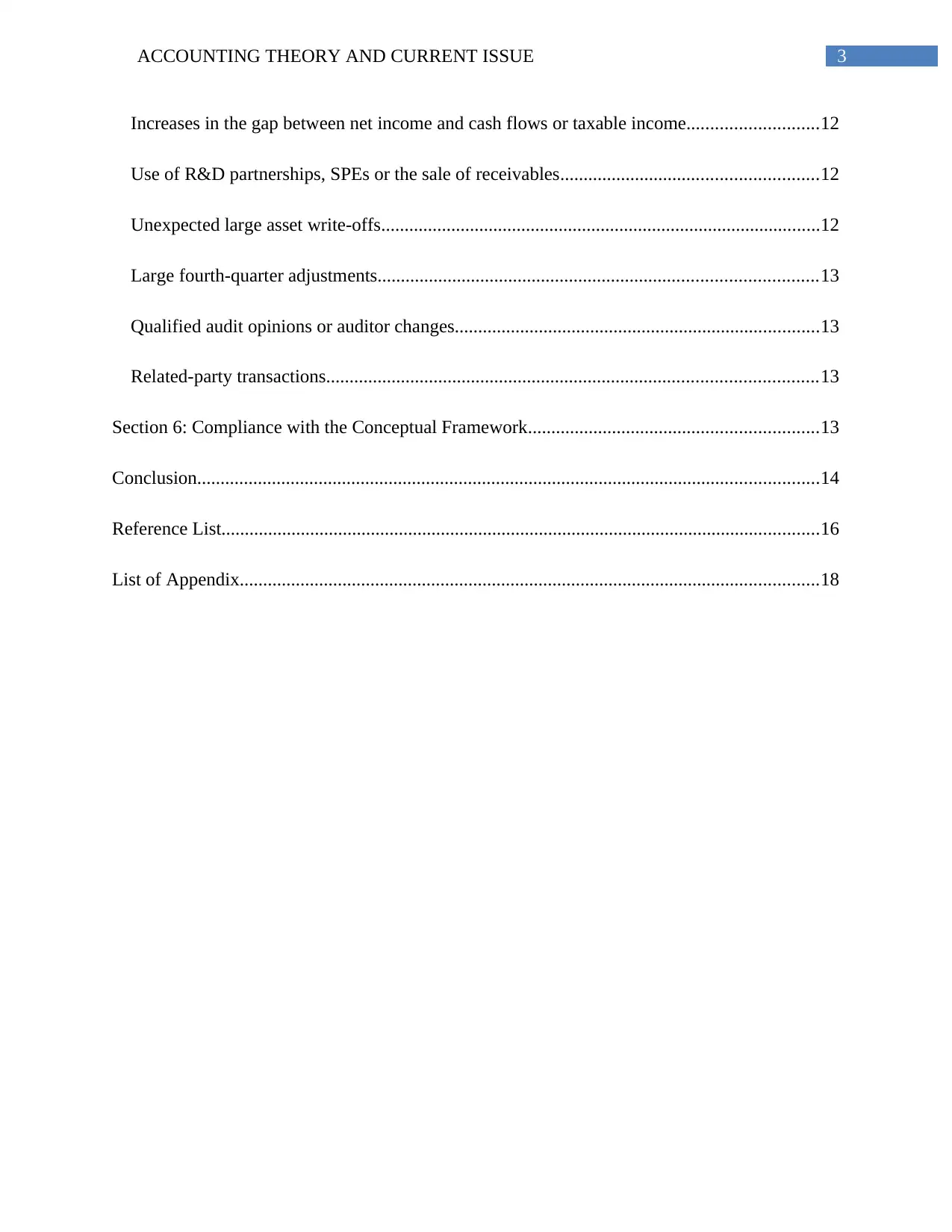
3ACCOUNTING THEORY AND CURRENT ISSUE
Increases in the gap between net income and cash flows or taxable income............................12
Use of R&D partnerships, SPEs or the sale of receivables.......................................................12
Unexpected large asset write-offs..............................................................................................12
Large fourth-quarter adjustments..............................................................................................13
Qualified audit opinions or auditor changes..............................................................................13
Related-party transactions.........................................................................................................13
Section 6: Compliance with the Conceptual Framework..............................................................13
Conclusion.....................................................................................................................................14
Reference List................................................................................................................................16
List of Appendix............................................................................................................................18
Increases in the gap between net income and cash flows or taxable income............................12
Use of R&D partnerships, SPEs or the sale of receivables.......................................................12
Unexpected large asset write-offs..............................................................................................12
Large fourth-quarter adjustments..............................................................................................13
Qualified audit opinions or auditor changes..............................................................................13
Related-party transactions.........................................................................................................13
Section 6: Compliance with the Conceptual Framework..............................................................13
Conclusion.....................................................................................................................................14
Reference List................................................................................................................................16
List of Appendix............................................................................................................................18
Paraphrase This Document
Need a fresh take? Get an instant paraphrase of this document with our AI Paraphraser
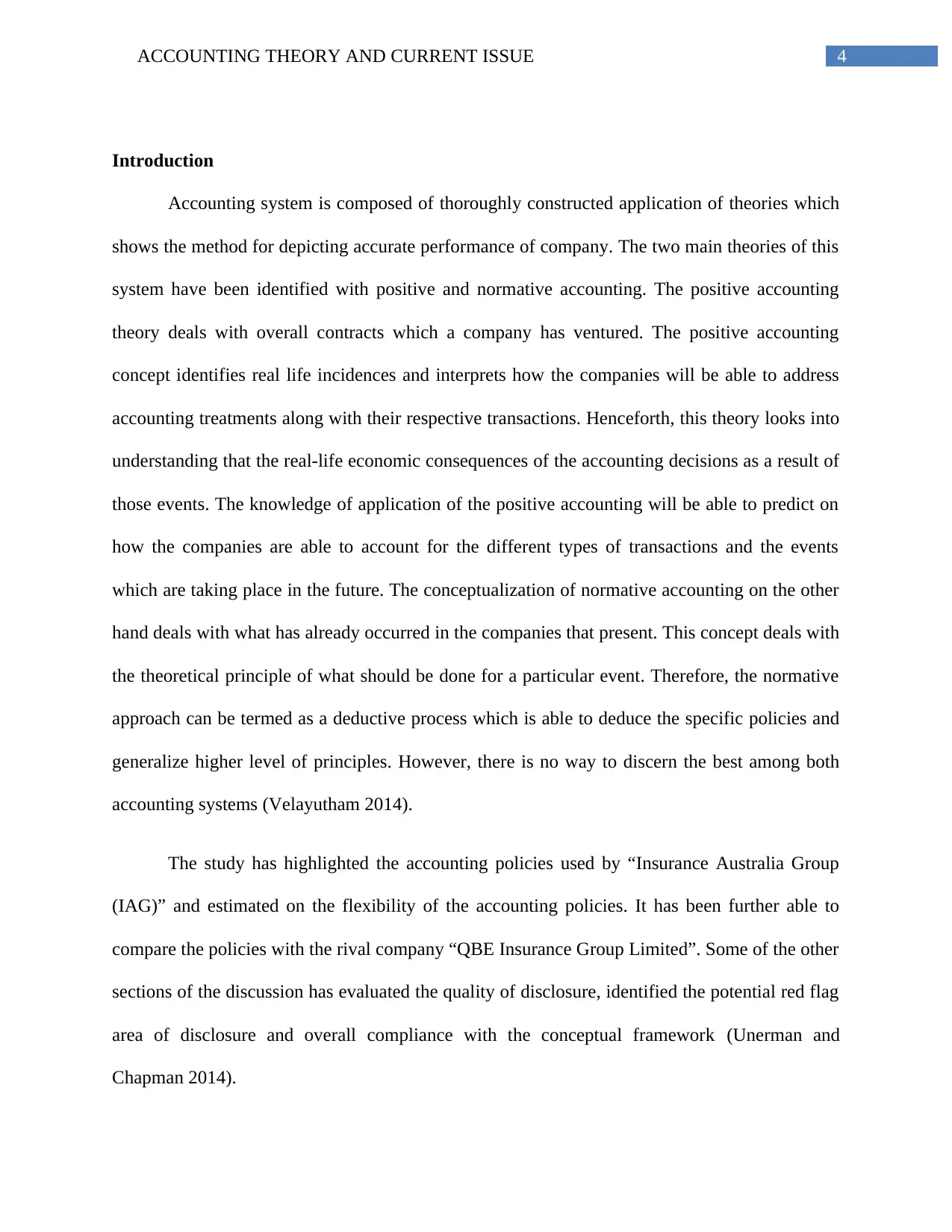
4ACCOUNTING THEORY AND CURRENT ISSUE
Introduction
Accounting system is composed of thoroughly constructed application of theories which
shows the method for depicting accurate performance of company. The two main theories of this
system have been identified with positive and normative accounting. The positive accounting
theory deals with overall contracts which a company has ventured. The positive accounting
concept identifies real life incidences and interprets how the companies will be able to address
accounting treatments along with their respective transactions. Henceforth, this theory looks into
understanding that the real-life economic consequences of the accounting decisions as a result of
those events. The knowledge of application of the positive accounting will be able to predict on
how the companies are able to account for the different types of transactions and the events
which are taking place in the future. The conceptualization of normative accounting on the other
hand deals with what has already occurred in the companies that present. This concept deals with
the theoretical principle of what should be done for a particular event. Therefore, the normative
approach can be termed as a deductive process which is able to deduce the specific policies and
generalize higher level of principles. However, there is no way to discern the best among both
accounting systems (Velayutham 2014).
The study has highlighted the accounting policies used by “Insurance Australia Group
(IAG)” and estimated on the flexibility of the accounting policies. It has been further able to
compare the policies with the rival company “QBE Insurance Group Limited”. Some of the other
sections of the discussion has evaluated the quality of disclosure, identified the potential red flag
area of disclosure and overall compliance with the conceptual framework (Unerman and
Chapman 2014).
Introduction
Accounting system is composed of thoroughly constructed application of theories which
shows the method for depicting accurate performance of company. The two main theories of this
system have been identified with positive and normative accounting. The positive accounting
theory deals with overall contracts which a company has ventured. The positive accounting
concept identifies real life incidences and interprets how the companies will be able to address
accounting treatments along with their respective transactions. Henceforth, this theory looks into
understanding that the real-life economic consequences of the accounting decisions as a result of
those events. The knowledge of application of the positive accounting will be able to predict on
how the companies are able to account for the different types of transactions and the events
which are taking place in the future. The conceptualization of normative accounting on the other
hand deals with what has already occurred in the companies that present. This concept deals with
the theoretical principle of what should be done for a particular event. Therefore, the normative
approach can be termed as a deductive process which is able to deduce the specific policies and
generalize higher level of principles. However, there is no way to discern the best among both
accounting systems (Velayutham 2014).
The study has highlighted the accounting policies used by “Insurance Australia Group
(IAG)” and estimated on the flexibility of the accounting policies. It has been further able to
compare the policies with the rival company “QBE Insurance Group Limited”. Some of the other
sections of the discussion has evaluated the quality of disclosure, identified the potential red flag
area of disclosure and overall compliance with the conceptual framework (Unerman and
Chapman 2014).
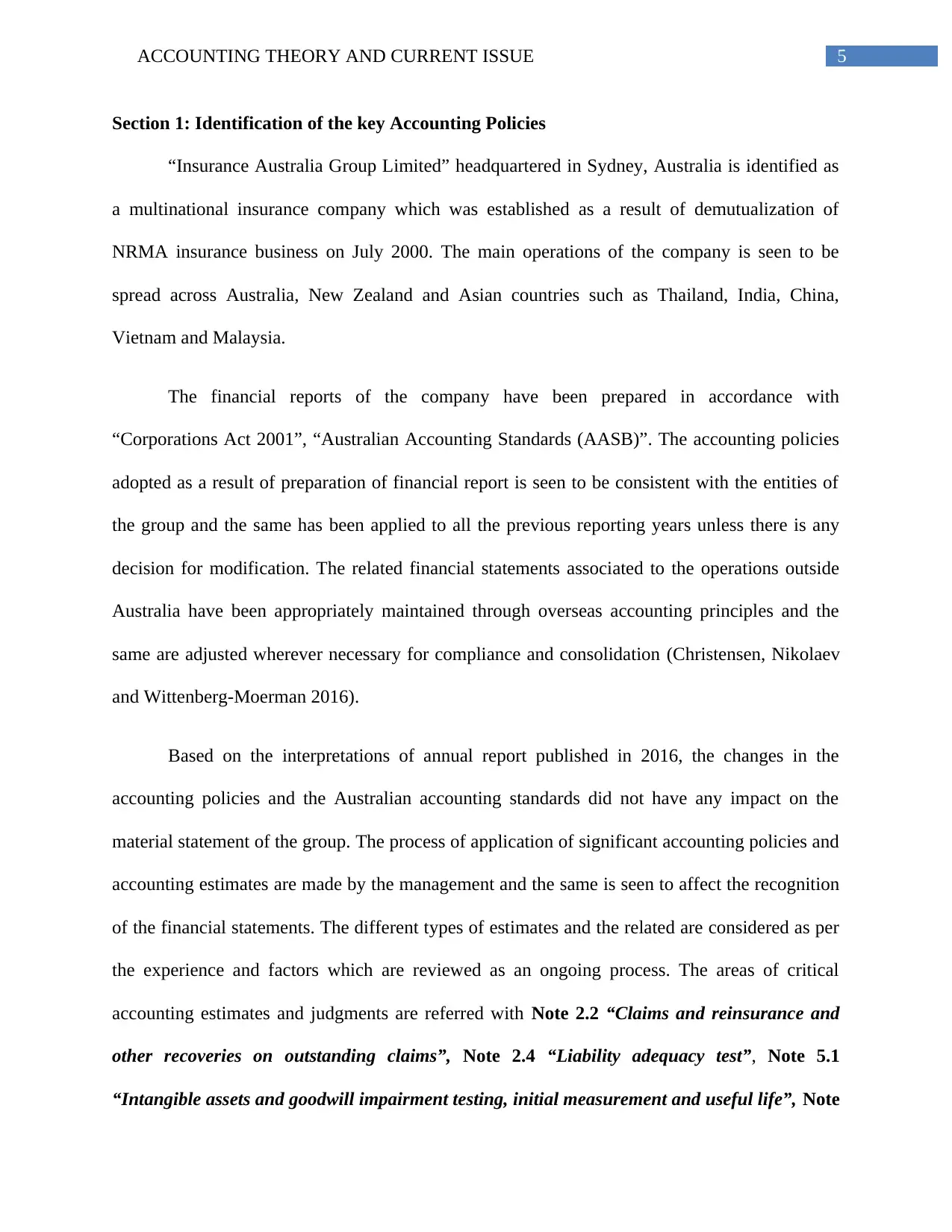
5ACCOUNTING THEORY AND CURRENT ISSUE
Section 1: Identification of the key Accounting Policies
“Insurance Australia Group Limited” headquartered in Sydney, Australia is identified as
a multinational insurance company which was established as a result of demutualization of
NRMA insurance business on July 2000. The main operations of the company is seen to be
spread across Australia, New Zealand and Asian countries such as Thailand, India, China,
Vietnam and Malaysia.
The financial reports of the company have been prepared in accordance with
“Corporations Act 2001”, “Australian Accounting Standards (AASB)”. The accounting policies
adopted as a result of preparation of financial report is seen to be consistent with the entities of
the group and the same has been applied to all the previous reporting years unless there is any
decision for modification. The related financial statements associated to the operations outside
Australia have been appropriately maintained through overseas accounting principles and the
same are adjusted wherever necessary for compliance and consolidation (Christensen, Nikolaev
and Wittenberg-Moerman 2016).
Based on the interpretations of annual report published in 2016, the changes in the
accounting policies and the Australian accounting standards did not have any impact on the
material statement of the group. The process of application of significant accounting policies and
accounting estimates are made by the management and the same is seen to affect the recognition
of the financial statements. The different types of estimates and the related are considered as per
the experience and factors which are reviewed as an ongoing process. The areas of critical
accounting estimates and judgments are referred with Note 2.2 “Claims and reinsurance and
other recoveries on outstanding claims”, Note 2.4 “Liability adequacy test”, Note 5.1
“Intangible assets and goodwill impairment testing, initial measurement and useful life”, Note
Section 1: Identification of the key Accounting Policies
“Insurance Australia Group Limited” headquartered in Sydney, Australia is identified as
a multinational insurance company which was established as a result of demutualization of
NRMA insurance business on July 2000. The main operations of the company is seen to be
spread across Australia, New Zealand and Asian countries such as Thailand, India, China,
Vietnam and Malaysia.
The financial reports of the company have been prepared in accordance with
“Corporations Act 2001”, “Australian Accounting Standards (AASB)”. The accounting policies
adopted as a result of preparation of financial report is seen to be consistent with the entities of
the group and the same has been applied to all the previous reporting years unless there is any
decision for modification. The related financial statements associated to the operations outside
Australia have been appropriately maintained through overseas accounting principles and the
same are adjusted wherever necessary for compliance and consolidation (Christensen, Nikolaev
and Wittenberg-Moerman 2016).
Based on the interpretations of annual report published in 2016, the changes in the
accounting policies and the Australian accounting standards did not have any impact on the
material statement of the group. The process of application of significant accounting policies and
accounting estimates are made by the management and the same is seen to affect the recognition
of the financial statements. The different types of estimates and the related are considered as per
the experience and factors which are reviewed as an ongoing process. The areas of critical
accounting estimates and judgments are referred with Note 2.2 “Claims and reinsurance and
other recoveries on outstanding claims”, Note 2.4 “Liability adequacy test”, Note 5.1
“Intangible assets and goodwill impairment testing, initial measurement and useful life”, Note
⊘ This is a preview!⊘
Do you want full access?
Subscribe today to unlock all pages.

Trusted by 1+ million students worldwide
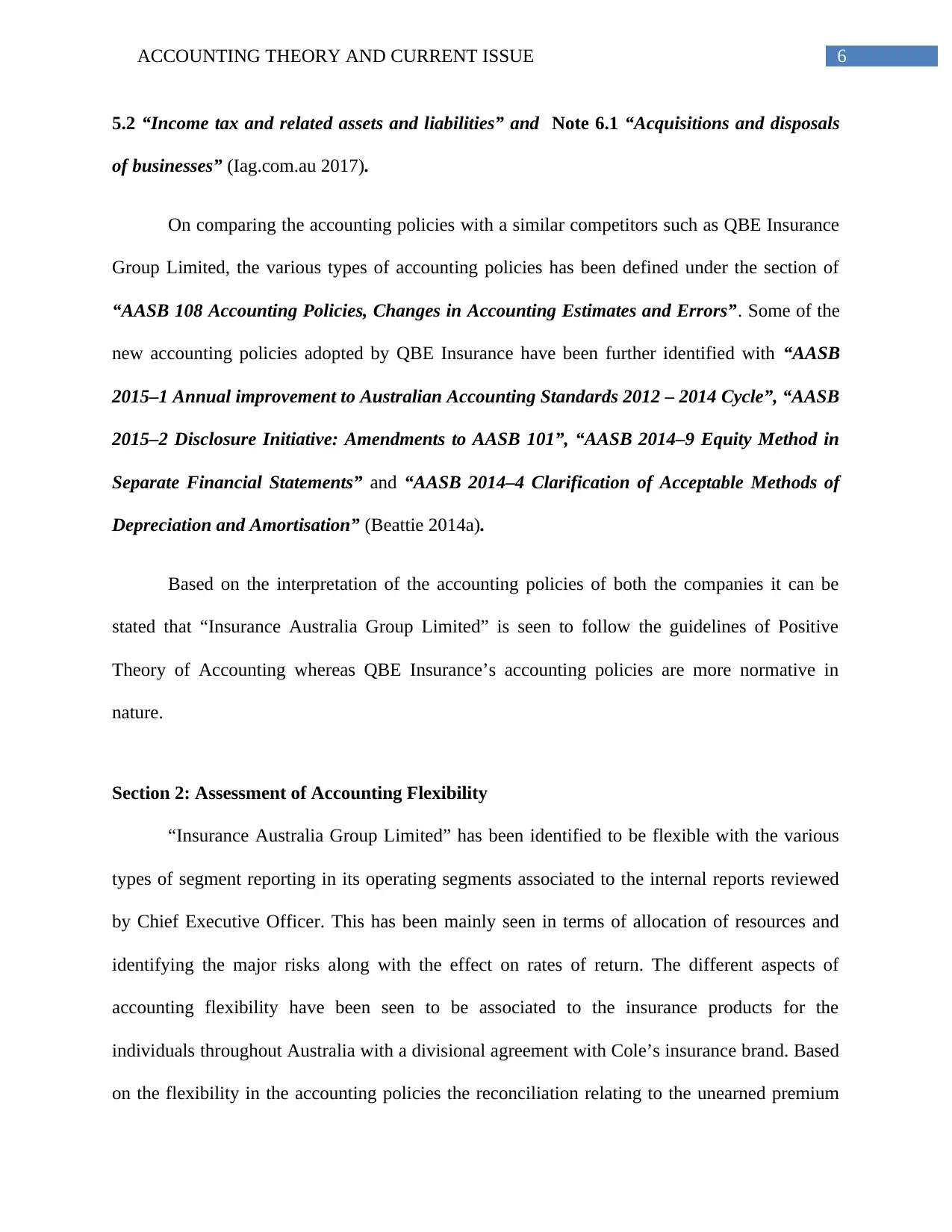
6ACCOUNTING THEORY AND CURRENT ISSUE
5.2 “Income tax and related assets and liabilities” and Note 6.1 “Acquisitions and disposals
of businesses” (Iag.com.au 2017).
On comparing the accounting policies with a similar competitors such as QBE Insurance
Group Limited, the various types of accounting policies has been defined under the section of
“AASB 108 Accounting Policies, Changes in Accounting Estimates and Errors”. Some of the
new accounting policies adopted by QBE Insurance have been further identified with “AASB
2015–1 Annual improvement to Australian Accounting Standards 2012 – 2014 Cycle”, “AASB
2015–2 Disclosure Initiative: Amendments to AASB 101”, “AASB 2014–9 Equity Method in
Separate Financial Statements” and “AASB 2014–4 Clarification of Acceptable Methods of
Depreciation and Amortisation” (Beattie 2014a).
Based on the interpretation of the accounting policies of both the companies it can be
stated that “Insurance Australia Group Limited” is seen to follow the guidelines of Positive
Theory of Accounting whereas QBE Insurance’s accounting policies are more normative in
nature.
Section 2: Assessment of Accounting Flexibility
“Insurance Australia Group Limited” has been identified to be flexible with the various
types of segment reporting in its operating segments associated to the internal reports reviewed
by Chief Executive Officer. This has been mainly seen in terms of allocation of resources and
identifying the major risks along with the effect on rates of return. The different aspects of
accounting flexibility have been seen to be associated to the insurance products for the
individuals throughout Australia with a divisional agreement with Cole’s insurance brand. Based
on the flexibility in the accounting policies the reconciliation relating to the unearned premium
5.2 “Income tax and related assets and liabilities” and Note 6.1 “Acquisitions and disposals
of businesses” (Iag.com.au 2017).
On comparing the accounting policies with a similar competitors such as QBE Insurance
Group Limited, the various types of accounting policies has been defined under the section of
“AASB 108 Accounting Policies, Changes in Accounting Estimates and Errors”. Some of the
new accounting policies adopted by QBE Insurance have been further identified with “AASB
2015–1 Annual improvement to Australian Accounting Standards 2012 – 2014 Cycle”, “AASB
2015–2 Disclosure Initiative: Amendments to AASB 101”, “AASB 2014–9 Equity Method in
Separate Financial Statements” and “AASB 2014–4 Clarification of Acceptable Methods of
Depreciation and Amortisation” (Beattie 2014a).
Based on the interpretation of the accounting policies of both the companies it can be
stated that “Insurance Australia Group Limited” is seen to follow the guidelines of Positive
Theory of Accounting whereas QBE Insurance’s accounting policies are more normative in
nature.
Section 2: Assessment of Accounting Flexibility
“Insurance Australia Group Limited” has been identified to be flexible with the various
types of segment reporting in its operating segments associated to the internal reports reviewed
by Chief Executive Officer. This has been mainly seen in terms of allocation of resources and
identifying the major risks along with the effect on rates of return. The different aspects of
accounting flexibility have been seen to be associated to the insurance products for the
individuals throughout Australia with a divisional agreement with Cole’s insurance brand. Based
on the flexibility in the accounting policies the reconciliation relating to the unearned premium
Paraphrase This Document
Need a fresh take? Get an instant paraphrase of this document with our AI Paraphraser
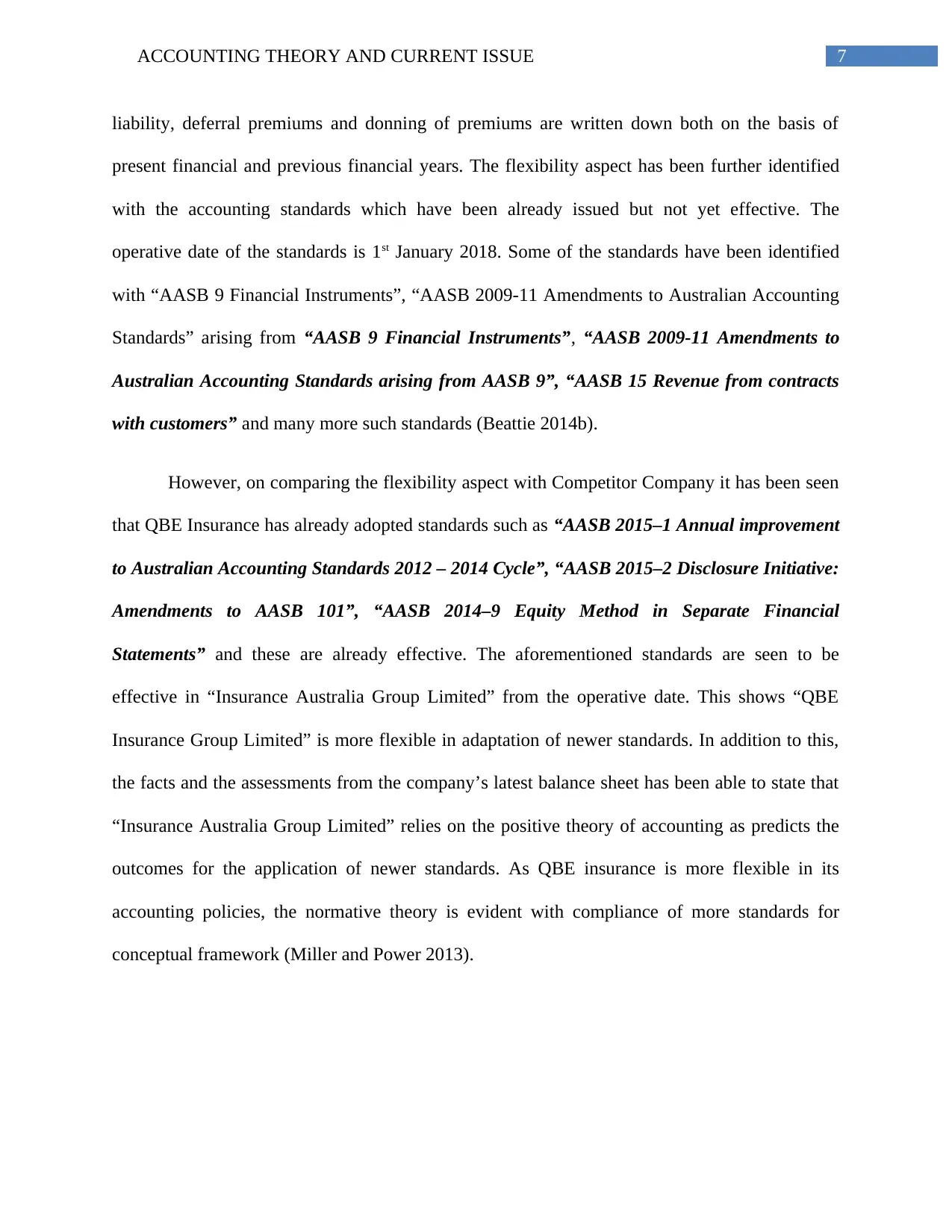
7ACCOUNTING THEORY AND CURRENT ISSUE
liability, deferral premiums and donning of premiums are written down both on the basis of
present financial and previous financial years. The flexibility aspect has been further identified
with the accounting standards which have been already issued but not yet effective. The
operative date of the standards is 1st January 2018. Some of the standards have been identified
with “AASB 9 Financial Instruments”, “AASB 2009-11 Amendments to Australian Accounting
Standards” arising from “AASB 9 Financial Instruments”, “AASB 2009-11 Amendments to
Australian Accounting Standards arising from AASB 9”, “AASB 15 Revenue from contracts
with customers” and many more such standards (Beattie 2014b).
However, on comparing the flexibility aspect with Competitor Company it has been seen
that QBE Insurance has already adopted standards such as “AASB 2015–1 Annual improvement
to Australian Accounting Standards 2012 – 2014 Cycle”, “AASB 2015–2 Disclosure Initiative:
Amendments to AASB 101”, “AASB 2014–9 Equity Method in Separate Financial
Statements” and these are already effective. The aforementioned standards are seen to be
effective in “Insurance Australia Group Limited” from the operative date. This shows “QBE
Insurance Group Limited” is more flexible in adaptation of newer standards. In addition to this,
the facts and the assessments from the company’s latest balance sheet has been able to state that
“Insurance Australia Group Limited” relies on the positive theory of accounting as predicts the
outcomes for the application of newer standards. As QBE insurance is more flexible in its
accounting policies, the normative theory is evident with compliance of more standards for
conceptual framework (Miller and Power 2013).
liability, deferral premiums and donning of premiums are written down both on the basis of
present financial and previous financial years. The flexibility aspect has been further identified
with the accounting standards which have been already issued but not yet effective. The
operative date of the standards is 1st January 2018. Some of the standards have been identified
with “AASB 9 Financial Instruments”, “AASB 2009-11 Amendments to Australian Accounting
Standards” arising from “AASB 9 Financial Instruments”, “AASB 2009-11 Amendments to
Australian Accounting Standards arising from AASB 9”, “AASB 15 Revenue from contracts
with customers” and many more such standards (Beattie 2014b).
However, on comparing the flexibility aspect with Competitor Company it has been seen
that QBE Insurance has already adopted standards such as “AASB 2015–1 Annual improvement
to Australian Accounting Standards 2012 – 2014 Cycle”, “AASB 2015–2 Disclosure Initiative:
Amendments to AASB 101”, “AASB 2014–9 Equity Method in Separate Financial
Statements” and these are already effective. The aforementioned standards are seen to be
effective in “Insurance Australia Group Limited” from the operative date. This shows “QBE
Insurance Group Limited” is more flexible in adaptation of newer standards. In addition to this,
the facts and the assessments from the company’s latest balance sheet has been able to state that
“Insurance Australia Group Limited” relies on the positive theory of accounting as predicts the
outcomes for the application of newer standards. As QBE insurance is more flexible in its
accounting policies, the normative theory is evident with compliance of more standards for
conceptual framework (Miller and Power 2013).
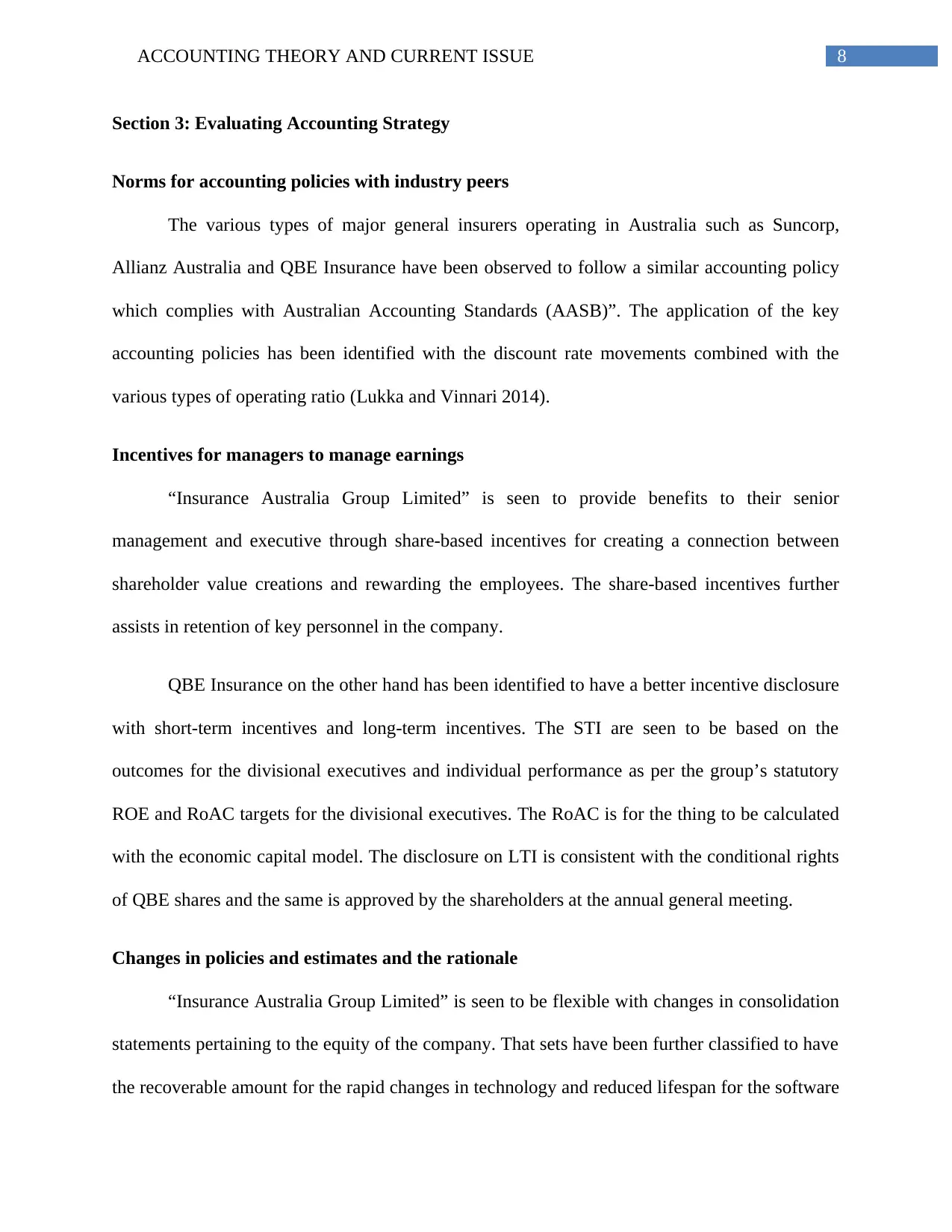
8ACCOUNTING THEORY AND CURRENT ISSUE
Section 3: Evaluating Accounting Strategy
Norms for accounting policies with industry peers
The various types of major general insurers operating in Australia such as Suncorp,
Allianz Australia and QBE Insurance have been observed to follow a similar accounting policy
which complies with Australian Accounting Standards (AASB)”. The application of the key
accounting policies has been identified with the discount rate movements combined with the
various types of operating ratio (Lukka and Vinnari 2014).
Incentives for managers to manage earnings
“Insurance Australia Group Limited” is seen to provide benefits to their senior
management and executive through share-based incentives for creating a connection between
shareholder value creations and rewarding the employees. The share-based incentives further
assists in retention of key personnel in the company.
QBE Insurance on the other hand has been identified to have a better incentive disclosure
with short-term incentives and long-term incentives. The STI are seen to be based on the
outcomes for the divisional executives and individual performance as per the group’s statutory
ROE and RoAC targets for the divisional executives. The RoAC is for the thing to be calculated
with the economic capital model. The disclosure on LTI is consistent with the conditional rights
of QBE shares and the same is approved by the shareholders at the annual general meeting.
Changes in policies and estimates and the rationale
“Insurance Australia Group Limited” is seen to be flexible with changes in consolidation
statements pertaining to the equity of the company. That sets have been further classified to have
the recoverable amount for the rapid changes in technology and reduced lifespan for the software
Section 3: Evaluating Accounting Strategy
Norms for accounting policies with industry peers
The various types of major general insurers operating in Australia such as Suncorp,
Allianz Australia and QBE Insurance have been observed to follow a similar accounting policy
which complies with Australian Accounting Standards (AASB)”. The application of the key
accounting policies has been identified with the discount rate movements combined with the
various types of operating ratio (Lukka and Vinnari 2014).
Incentives for managers to manage earnings
“Insurance Australia Group Limited” is seen to provide benefits to their senior
management and executive through share-based incentives for creating a connection between
shareholder value creations and rewarding the employees. The share-based incentives further
assists in retention of key personnel in the company.
QBE Insurance on the other hand has been identified to have a better incentive disclosure
with short-term incentives and long-term incentives. The STI are seen to be based on the
outcomes for the divisional executives and individual performance as per the group’s statutory
ROE and RoAC targets for the divisional executives. The RoAC is for the thing to be calculated
with the economic capital model. The disclosure on LTI is consistent with the conditional rights
of QBE shares and the same is approved by the shareholders at the annual general meeting.
Changes in policies and estimates and the rationale
“Insurance Australia Group Limited” is seen to be flexible with changes in consolidation
statements pertaining to the equity of the company. That sets have been further classified to have
the recoverable amount for the rapid changes in technology and reduced lifespan for the software
⊘ This is a preview!⊘
Do you want full access?
Subscribe today to unlock all pages.

Trusted by 1+ million students worldwide
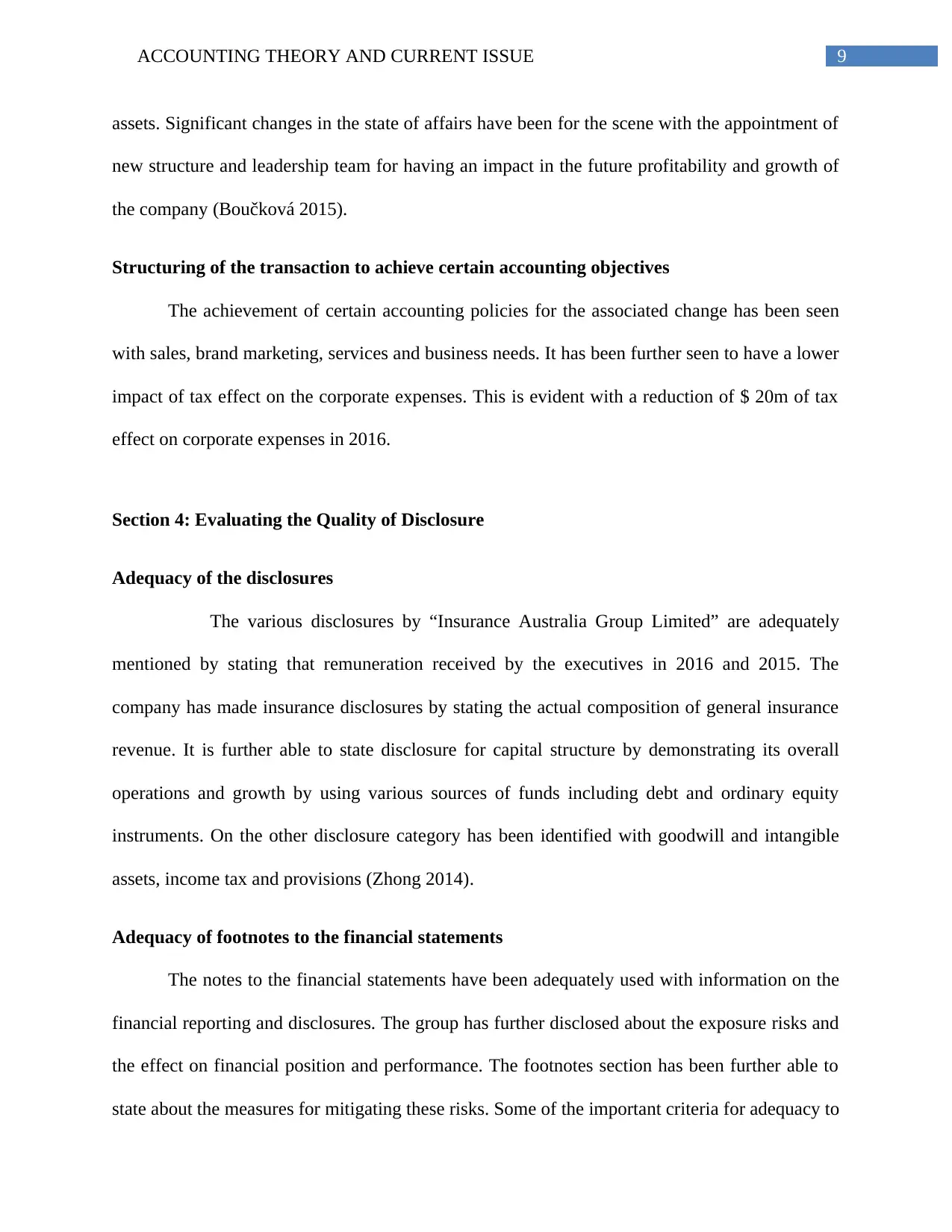
9ACCOUNTING THEORY AND CURRENT ISSUE
assets. Significant changes in the state of affairs have been for the scene with the appointment of
new structure and leadership team for having an impact in the future profitability and growth of
the company (Boučková 2015).
Structuring of the transaction to achieve certain accounting objectives
The achievement of certain accounting policies for the associated change has been seen
with sales, brand marketing, services and business needs. It has been further seen to have a lower
impact of tax effect on the corporate expenses. This is evident with a reduction of $ 20m of tax
effect on corporate expenses in 2016.
Section 4: Evaluating the Quality of Disclosure
Adequacy of the disclosures
The various disclosures by “Insurance Australia Group Limited” are adequately
mentioned by stating that remuneration received by the executives in 2016 and 2015. The
company has made insurance disclosures by stating the actual composition of general insurance
revenue. It is further able to state disclosure for capital structure by demonstrating its overall
operations and growth by using various sources of funds including debt and ordinary equity
instruments. On the other disclosure category has been identified with goodwill and intangible
assets, income tax and provisions (Zhong 2014).
Adequacy of footnotes to the financial statements
The notes to the financial statements have been adequately used with information on the
financial reporting and disclosures. The group has further disclosed about the exposure risks and
the effect on financial position and performance. The footnotes section has been further able to
state about the measures for mitigating these risks. Some of the important criteria for adequacy to
assets. Significant changes in the state of affairs have been for the scene with the appointment of
new structure and leadership team for having an impact in the future profitability and growth of
the company (Boučková 2015).
Structuring of the transaction to achieve certain accounting objectives
The achievement of certain accounting policies for the associated change has been seen
with sales, brand marketing, services and business needs. It has been further seen to have a lower
impact of tax effect on the corporate expenses. This is evident with a reduction of $ 20m of tax
effect on corporate expenses in 2016.
Section 4: Evaluating the Quality of Disclosure
Adequacy of the disclosures
The various disclosures by “Insurance Australia Group Limited” are adequately
mentioned by stating that remuneration received by the executives in 2016 and 2015. The
company has made insurance disclosures by stating the actual composition of general insurance
revenue. It is further able to state disclosure for capital structure by demonstrating its overall
operations and growth by using various sources of funds including debt and ordinary equity
instruments. On the other disclosure category has been identified with goodwill and intangible
assets, income tax and provisions (Zhong 2014).
Adequacy of footnotes to the financial statements
The notes to the financial statements have been adequately used with information on the
financial reporting and disclosures. The group has further disclosed about the exposure risks and
the effect on financial position and performance. The footnotes section has been further able to
state about the measures for mitigating these risks. Some of the important criteria for adequacy to
Paraphrase This Document
Need a fresh take? Get an instant paraphrase of this document with our AI Paraphraser
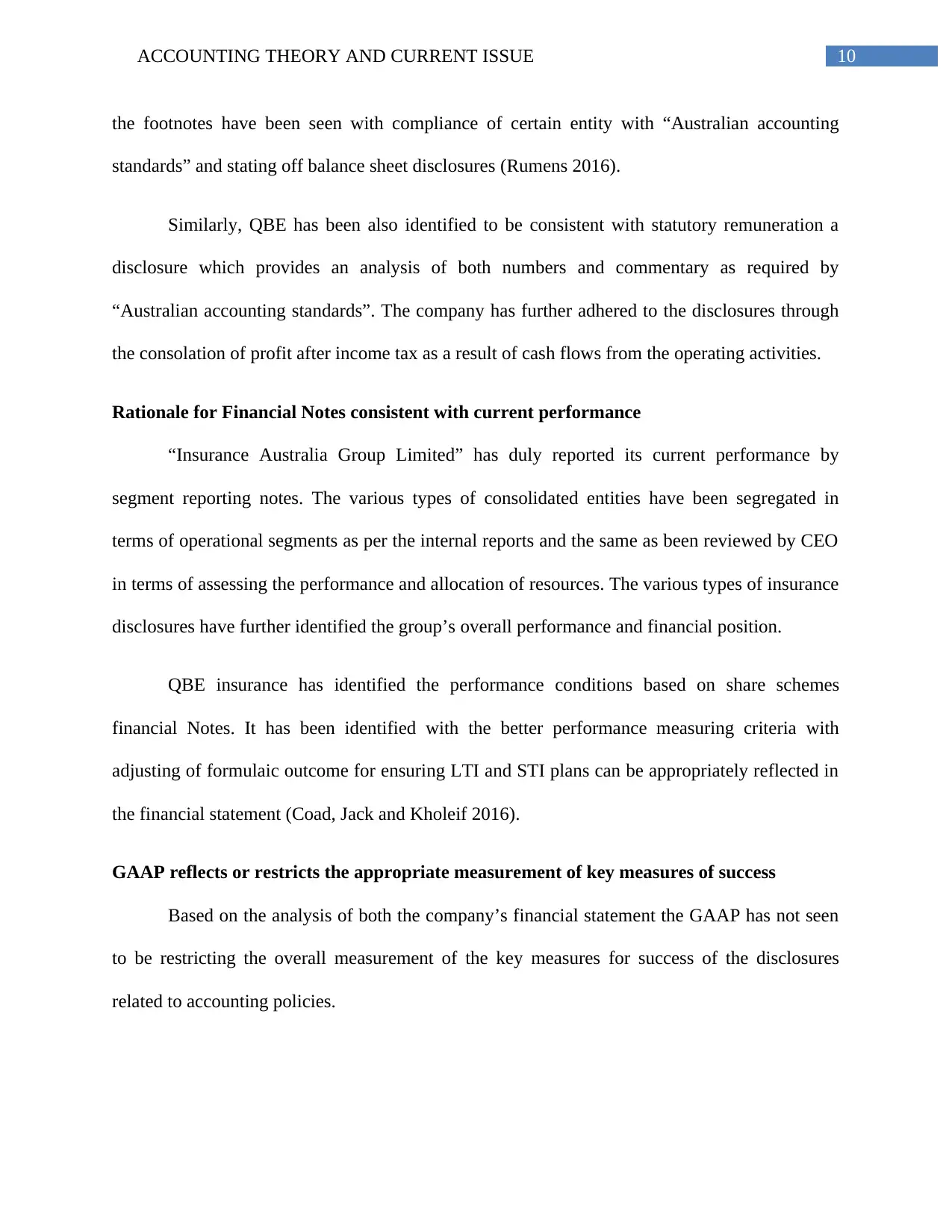
10ACCOUNTING THEORY AND CURRENT ISSUE
the footnotes have been seen with compliance of certain entity with “Australian accounting
standards” and stating off balance sheet disclosures (Rumens 2016).
Similarly, QBE has been also identified to be consistent with statutory remuneration a
disclosure which provides an analysis of both numbers and commentary as required by
“Australian accounting standards”. The company has further adhered to the disclosures through
the consolation of profit after income tax as a result of cash flows from the operating activities.
Rationale for Financial Notes consistent with current performance
“Insurance Australia Group Limited” has duly reported its current performance by
segment reporting notes. The various types of consolidated entities have been segregated in
terms of operational segments as per the internal reports and the same as been reviewed by CEO
in terms of assessing the performance and allocation of resources. The various types of insurance
disclosures have further identified the group’s overall performance and financial position.
QBE insurance has identified the performance conditions based on share schemes
financial Notes. It has been identified with the better performance measuring criteria with
adjusting of formulaic outcome for ensuring LTI and STI plans can be appropriately reflected in
the financial statement (Coad, Jack and Kholeif 2016).
GAAP reflects or restricts the appropriate measurement of key measures of success
Based on the analysis of both the company’s financial statement the GAAP has not seen
to be restricting the overall measurement of the key measures for success of the disclosures
related to accounting policies.
the footnotes have been seen with compliance of certain entity with “Australian accounting
standards” and stating off balance sheet disclosures (Rumens 2016).
Similarly, QBE has been also identified to be consistent with statutory remuneration a
disclosure which provides an analysis of both numbers and commentary as required by
“Australian accounting standards”. The company has further adhered to the disclosures through
the consolation of profit after income tax as a result of cash flows from the operating activities.
Rationale for Financial Notes consistent with current performance
“Insurance Australia Group Limited” has duly reported its current performance by
segment reporting notes. The various types of consolidated entities have been segregated in
terms of operational segments as per the internal reports and the same as been reviewed by CEO
in terms of assessing the performance and allocation of resources. The various types of insurance
disclosures have further identified the group’s overall performance and financial position.
QBE insurance has identified the performance conditions based on share schemes
financial Notes. It has been identified with the better performance measuring criteria with
adjusting of formulaic outcome for ensuring LTI and STI plans can be appropriately reflected in
the financial statement (Coad, Jack and Kholeif 2016).
GAAP reflects or restricts the appropriate measurement of key measures of success
Based on the analysis of both the company’s financial statement the GAAP has not seen
to be restricting the overall measurement of the key measures for success of the disclosures
related to accounting policies.
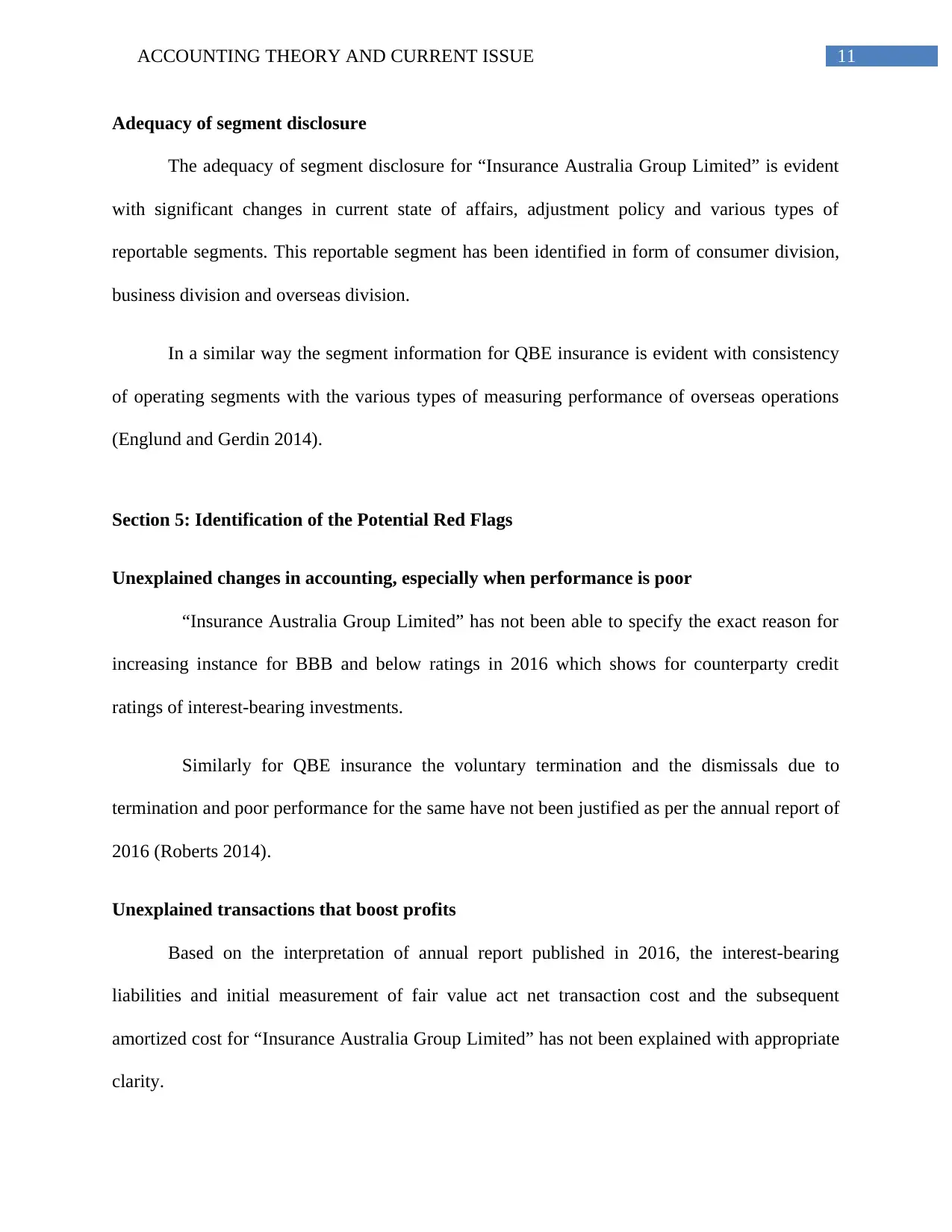
11ACCOUNTING THEORY AND CURRENT ISSUE
Adequacy of segment disclosure
The adequacy of segment disclosure for “Insurance Australia Group Limited” is evident
with significant changes in current state of affairs, adjustment policy and various types of
reportable segments. This reportable segment has been identified in form of consumer division,
business division and overseas division.
In a similar way the segment information for QBE insurance is evident with consistency
of operating segments with the various types of measuring performance of overseas operations
(Englund and Gerdin 2014).
Section 5: Identification of the Potential Red Flags
Unexplained changes in accounting, especially when performance is poor
“Insurance Australia Group Limited” has not been able to specify the exact reason for
increasing instance for BBB and below ratings in 2016 which shows for counterparty credit
ratings of interest-bearing investments.
Similarly for QBE insurance the voluntary termination and the dismissals due to
termination and poor performance for the same have not been justified as per the annual report of
2016 (Roberts 2014).
Unexplained transactions that boost profits
Based on the interpretation of annual report published in 2016, the interest-bearing
liabilities and initial measurement of fair value act net transaction cost and the subsequent
amortized cost for “Insurance Australia Group Limited” has not been explained with appropriate
clarity.
Adequacy of segment disclosure
The adequacy of segment disclosure for “Insurance Australia Group Limited” is evident
with significant changes in current state of affairs, adjustment policy and various types of
reportable segments. This reportable segment has been identified in form of consumer division,
business division and overseas division.
In a similar way the segment information for QBE insurance is evident with consistency
of operating segments with the various types of measuring performance of overseas operations
(Englund and Gerdin 2014).
Section 5: Identification of the Potential Red Flags
Unexplained changes in accounting, especially when performance is poor
“Insurance Australia Group Limited” has not been able to specify the exact reason for
increasing instance for BBB and below ratings in 2016 which shows for counterparty credit
ratings of interest-bearing investments.
Similarly for QBE insurance the voluntary termination and the dismissals due to
termination and poor performance for the same have not been justified as per the annual report of
2016 (Roberts 2014).
Unexplained transactions that boost profits
Based on the interpretation of annual report published in 2016, the interest-bearing
liabilities and initial measurement of fair value act net transaction cost and the subsequent
amortized cost for “Insurance Australia Group Limited” has not been explained with appropriate
clarity.
⊘ This is a preview!⊘
Do you want full access?
Subscribe today to unlock all pages.

Trusted by 1+ million students worldwide
1 out of 29
Related Documents
Your All-in-One AI-Powered Toolkit for Academic Success.
+13062052269
info@desklib.com
Available 24*7 on WhatsApp / Email
![[object Object]](/_next/static/media/star-bottom.7253800d.svg)
Unlock your academic potential
Copyright © 2020–2025 A2Z Services. All Rights Reserved. Developed and managed by ZUCOL.





